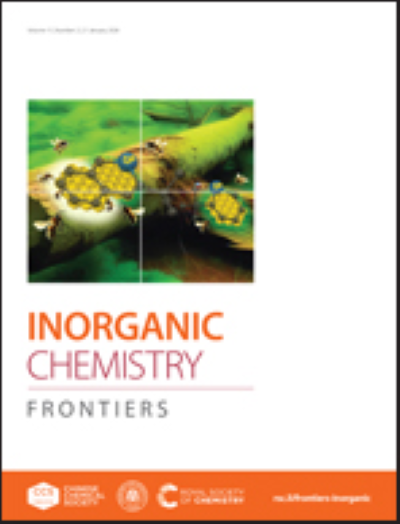独特的单/双三叶结和[2]链烷组件的战略合成和近红外光热转换
IF 6.1
1区 化学
Q1 CHEMISTRY, INORGANIC & NUCLEAR
引用次数: 0
摘要
分子结和链烷的罕见分子结构及其在各种领域的应用前景近年来引起了人们的关注。然而,它们的选择性合成仍然是一个主要的挑战。本文合成了一种新的具有两个苯基共轭基团和两个亚甲基的双咪唑柔性配体前体L1。此外,我们选择了5个具有不同大小和官能团的半三明治结构的建筑单元(B1-B5),通过经典的协调驱动自组装策略与化合物L1结合,产生不同的分子结和链链烷。由此分离出一个双三叶结、两个三叶结、一个d型[2]链烷和一个金属大环,产量显著。有趣的是,d形的[2]- catenane - 2在光照射和Cl -⁻的引入下可以转化为金属大环1。单晶x射线衍射分析、核磁共振波谱和ESI-TOF-MS均明确证实了所有指示结构的形成。光热转换研究表明,双三叶结5在近红外(NIR)实验中表现出显著的光热转换效率(31.32% ~ 40.28%),这可归因于其独特的拓扑结构和π-π堆叠相互作用。电子顺磁共振(EPR)实验完全证实了记录的结果。本文章由计算机程序翻译,如有差异,请以英文原文为准。
Strategic synthesis and near-infrared photothermal conversion of unique single/double trefoil knots and [2]catenane assemblies
The rare molecular structures and application possibilities in a variety of fields has attracted the attention to molecular knots and catenanes in recent years. However, their selective synthesis remains a major challenge. Herein, a new diimidazole-based flexible ligand precursor L1 possessing two phenyl conjugated groups and two methylene moieties has been synthesized. In addition, five half-sandwich-based building units (B1-B5) featuring different sizes and functional groups were selected to combine with compound L1 for generating different molecular knots and catenanes, by following a classical coordination-driven self-assembly strategy. Thus, one double trefoil knot, two trefoil knots, one D-type [2]catenane and one metallamacrocycle have been isolated in remarkable yields. Interestingly, the D-shaped [2]catenane 2 could be converted into metallamacrocycle 1 upon light irradiation and introduction of Cl⁻ ions. The formation of all the indicated structures has been unequivocally confirmed by single-crystal X-ray diffraction analysis, NMR spectroscopy and ESI-TOF-MS. Photothermal conversion studies showed that the double trefoil knot 5 exhibits remarkable photothermal conversion efficiency in near-infrared (NIR) experiments (31.32% - 40.28%), which can be attributed to its unique topological structure and π-π stacking interactions. Electron paramagnetic resonance (EPR) experiments fully confirmed the recorded results.
求助全文
通过发布文献求助,成功后即可免费获取论文全文。
去求助
来源期刊

Inorganic Chemistry Frontiers
CHEMISTRY, INORGANIC & NUCLEAR-
CiteScore
10.40
自引率
7.10%
发文量
587
审稿时长
1.2 months
期刊介绍:
The international, high quality journal for interdisciplinary research between inorganic chemistry and related subjects
 求助内容:
求助内容: 应助结果提醒方式:
应助结果提醒方式:


